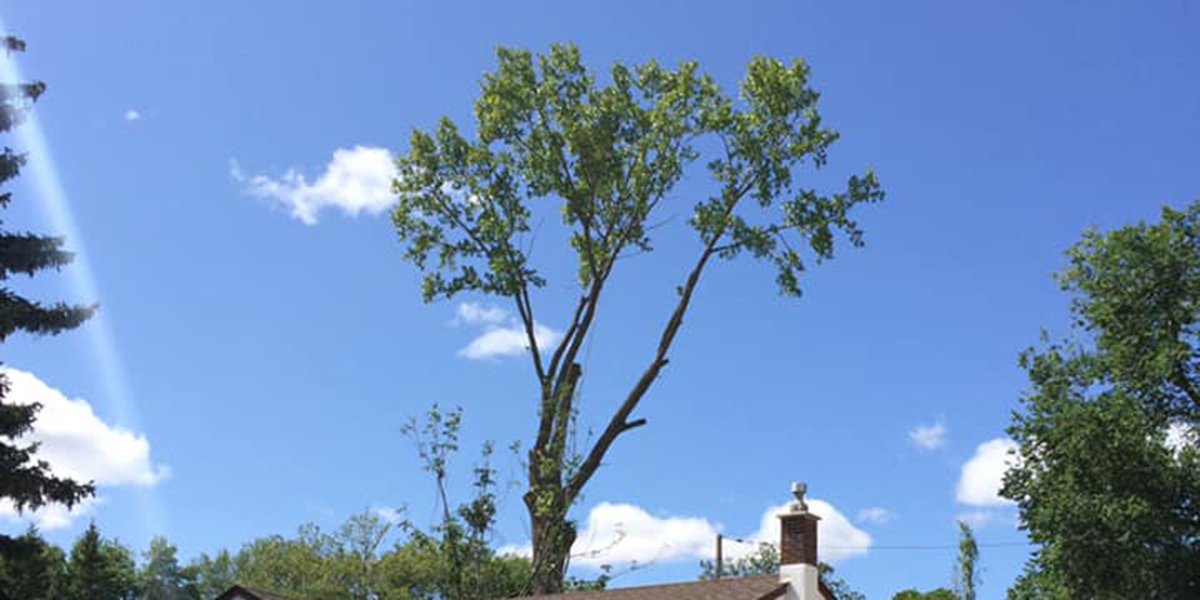As the leading independent tree removal company in Winnipeg, MB, our licensed arborists at Mitchel’s All Season Tree Experts answer all kinds of questions from residents and business owners about whether their trees can weather a strong storm. Inquiries like “How far can a tree lean before it falls?” and “What is a warning sign of decay that can affect the structural integrity of a hazard tree?” are more common than you think.
Our arborists will explain why trees lean until they fall in this explainer. We will also outline a few signs you must watch out for to prevent damage to your home or car when a tree shows signs of a structural imbalance.

How Far Can a Tree Lean Before It Falls?
Trees fall for hundreds of reasons that can sometimes compound. Leaning is usually non-fatal for trees, but signs of disease and malnutrition can kill them and cause them to become falling hazards. Look out for these signs your tree might be a falling hazard:
- Uprooted and surfacing roots usually mean your tree is not getting enough oxygen and nutrients from the ground
- Discolored crowns are signs of vascular blockages and disease
- Cracked barks often signify infestation from boring insects
- Epicormic growths usually mean your tree is sustaining stress from transplantation and other environmental factors
How far can a tree lean before it falls? Call an arborist for a checkup if your tree leans at an angle that exceeds 15 degrees. Prevent injury and lawsuits if your tree is near your home, a public sidewalk, or a parking space by acting fast. Tree trunks weigh hundreds of pounds, which means they can crack foundations, shatter windows, and destroy entire houses.
Why Do Trees Lean?
Most trees will grow perfectly straight trunks in ideal living situations. Species in areas where the soil has plenty of nutrients and sunlight is abundant are unlikely to develop leans or structural integrity issues.
Like all living creatures, trees depend on a habitable environment and a steady supply of nutrients to survive. Most species have survived millions of years through droughts and torrential rains without human intervention. However, trees today grow near suburban roads and in backyards, where they do not have the protection of a deciduous forest to shield them from high winds and other seasonal effects.
Hundreds of trees in urban areas lean or grow so awkwardly that people wonder how they are still attached to the ground. Trees develop two types of structural integrity problems that make them lean:
- Curved trunks that appear straight from the base and then lean several feet from the ground
- Straight trunks that grow diagonally from the ground up
Arborists do not have a technical term for these two issues, but most agree that the first problem results in less stress directed toward the roots. The second problem often results in uprooting, which can kill a tree a few days after an adverse weather event.
Here are a few other causes of tree-leaning:
- High winds that last several weeks from one direction
- Soil that does not have enough moisture or nutrients, leading to root growth in one direction.
- Branches that intertwine with pillars, power lines, and other supporting structures
Call a Tree Care Expert Today
Although Canada has a goal to plant 2 billion new trees by 2030, old trees are prone to leaning, which can be dangerous. Learn essential facts about your environment, like how far can a tree lean before it falls or how to know if a tree is dead, by working with licensed arborists from Mitchel’s All Season Tree Experts. Call us at (204) 998-4559 for a free consultation.
